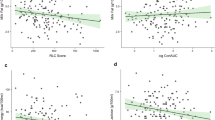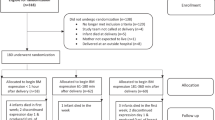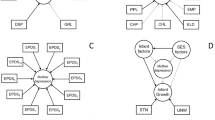Abstract
Objective:
(1) To compare maternal characteristics and psychological stress profile among African-American, Caucasian and Hispanic mothers who delivered very low birthweight infants. (2) To investigate associations between psychosocial factors, frequency of milk expression, skin-to-skin holding (STS), and lactation performance, defined as maternal drive to express milk and milk volume.
Study Design:
Self-reported psychological questionnaires were given every 2 weeks after delivery over 10 weeks. Milk expression frequency, STS, and socioeconomic variables were collected.
Result:
Infant birthweight, education, and milk expression frequency differed between groups. Trait anxiety, depression and parental stress in a neonatal intensive care unit (PSS:NICU) were similar. African-American and Caucasian mothers reported the lowest scores in state anxiety and social desirability, respectively. Maternal drive to express milk, measured by maintenance of milk expression, correlated negatively with parental role alteration (subset of PSS:NICU) and positively with infant birthweight and STS. Milk volume correlated negatively with depression and positively with milk expression frequency and STS.
Conclusion:
Differences between groups were observed for certain psychosocial factors. The response bias to self-reported questionnaires between groups may not provide an accurate profile of maternal psychosocial profile. With different factors correlating with maintenance of milk expression and milk volume, lactation performance can be best enhanced with a multi-faceted intervention program, incorporating parental involvement in infant care, close awareness and management of maternal mental health, and encouragement for frequent milk expression and STS.
This is a preview of subscription content, access via your institution
Access options
Subscribe to this journal
Receive 12 print issues and online access
$259.00 per year
only $21.58 per issue
Buy this article
- Purchase on Springer Link
- Instant access to full article PDF
Prices may be subject to local taxes which are calculated during checkout




Similar content being viewed by others
References
Gartner LM, Morton J, Lawrence RA, Naylor AJ, O'Hare D, Schanler RJ et al. Breastfeeding and the use of human milk. Pediatrics 2005; 115: 496–506.
American Academy of Pediatrics. Work group on breastfeeding: breastfeeding and the use of human milk. Pediatrics 1997; 100: 1035–1039.
Schanler RJ, Hurst NM, Lau C . The use of human milk and breastfeeding in premature infants. Clin Perinatol 1999; 26: 379–398 vii.
Hoyert DL, Mathews TJ, Menacker F, Strobino DM, Guyer B . Annual summary of vital statistics: 2004. Pediatrics 2006; 117: 168–183.
Wen SW, Smith G, Yang Q, Walker M . Epidemiology of preterm birth and neonatal outcome. Semin Fetal Neonatal Med 2004; 9: 429–435.
Ashton D . Prematurity – infant mortality: the scourge remains. Ethn Dis 2006; 16: S3–62.
Schanler RJ, Shulman RJ, Lau C . Feeding strategies for premature infants: beneficial outcomes of feeding fortified human milk versus preterm formula (comment). Pediatrics 1999; 103: 1150–1157.
Lau C . Effects of stress on lactation. Pediatr Clin North Am 2001; 48: 221–234.
Smith MM, Durkin M, Hinton VJ, Bellinger D, Kuhn L . Initiation of breastfeeding among mothers of very low birth weight infants. Pediatrics 2003; 111: 1337–1342.
Killersreiter B, Grimmer I, Buhrer C, Dudenhausen JW, Obladen M . Early cessation of breast milk feeding in very low birthweight infants. Early Hum Dev 2001; 60: 193–205.
Dayan J, Creveuil C, Marks MN, Conroy S, Herlicoviez M, Dreyfus M et al. Prenatal depression, prenatal anxiety, and spontaneous preterm birth: a prospective cohort study among women with early and regular care. Psychosom Med 2006; 68: 938–946.
Kofman O . The role of prenatal stress in the etiology of developmental behavioural disorders. Neurosci Biobehav Rev 2002; 26: 457–470.
Neville MC, Morton J, Umemura S . Lactogenesis. The transition from pregnancy to lactation. Pediatr Clin North Am 2001; 48: 35–52.
Dewey KG . Maternal and fetal stress are associated with impaired lactogenesis in humans. J Nutr 2001; 131: 3012S–3015S.
Chapman DJ, Perez-Escamilla R . Maternal perception of the onset of lactation is a valid, public health indicator of lactogenesis stage II. J Nutr 2000; 130: 2972–2980.
Lau C . The effect of stress on lactation – its significance for the preterm infant. Adv Exp Med Biol 2002; 503: 91–97.
Singer LT, Salvator A, Guo S, Collin M, Lilien L, Baley J . Maternal psychological distress and parenting stress after the birth of a very low-birth-weight infant. JAMA 1999; 281: 799–805.
Docherty SL, Miles MS, Holditch-Davis D . Worry about child health in mothers of hospitalized medically fragile infants. Adv Neonatal Care 2002; 2: 84–92.
Bergh AM . Obstacles to and motivation for successful breast-feeding. Curationis 1993; 16: 24–29.
Bertini G, Perugi S, Dani C, Pezzati M, Tronchin M, Rubaltelli FF . Maternal education and the incidence and duration of breast feeding: a prospective study. J Pediatr Gastroenterol Nutr 2003; 37: 447–452.
Beck CT . Recognizing and screening for postpartum depression in mothers of NICU infants. Adv Neonatal Care 2003; 3: 37–46.
DeMier RL, Hynan MT, Harris HB, Manniello RL . Perinatal stressors as predictors of symptoms of posttraumatic stress in mothers of infants at high risk. J Perinatol 1996; 16: 276–280.
Doering LV, Moser DK, Dracup K . Correlates of anxiety, hostility, depression, and psychosocial adjustment in parents of NICU infants. Neonatal Netw 2000; 19: 15–23.
Dole N, Savitz DA, Hertz-Picciotto I, Siega-Riz AM, McMahon MJ, Buekens P . Maternal stress and preterm birth. Am J Epidemiol 2003; 157: 14–24.
Holditch-Davis D, Bartlett TR, Blickman AL, Miles MS . Posttraumatic stress symptoms in mothers of premature infants. J Obstet Gynecol Neonatal Nurs 2003; 32: 161–171.
Meyer EC, Garcia Coll CT, Seifer R, Ramos A, Kilis E, Oh W . Psychological distress in mothers of preterm infants. J Dev Behav Pediatr 1995; 16: 412–417.
Zelkowitz P, Papageorgiou A . Maternal anxiety: an emerging prognostic factor in neonatology. Acta Paediatr 2005; 94: 1704–1705.
Hill PD, Aldag JC, Chatterton RT . Initiation and frequency of pumping and milk production in mothers of non-nursing preterm infants. J Hum Lact 2001; 17: 9–13.
Hopkinson JM, Schanler RJ, Garza C . Milk production by mothers of premature infants. Pediatrics 1988; 81: 815–820.
Hurst NM, Valentine CJ, Renfro L, Burns P, Ferlic L . Skin-to-skin holding in the neonatal intensive care unit influences maternal milk volume. J Perinatol 1997; 17: 213–217.
McGrath SK, Kennell JH . Extended mother-infant skin-to-skin contact and prospect of breastfeeding. Acta Paediatr 2002; 91: 1288–1289.
Mikiel-Kostyra K, Mazur J, Boltruszko I . Effect of early skin-to-skin contact after delivery on duration of breastfeeding: a prospective cohort study. Acta Paediatr 2002; 91: 1301–1306.
Kirsten GF, Bergman NJ, Hann FM . Kangaroo mother care in the nursery. Pediatr Clin North Am 2001; 48: 443–452.
Furman L, Minich N, Hack M . Correlates of lactation in mothers of very low birth weight infants. Pediatrics 2002; 109: E57.
Bonuck KA, Trombley M, Freeman K, McKee D . Randomized, controlled trial of a prenatal and postnatal lactation consultant intervention on duration and intensity of breastfeeding up to 12 months. Pediatrics 2005; 116: 1413–1426.
Gamble J, Creedy D, Moyle W, Webster J, McAllister M, Dickson P . Effectiveness of a counseling intervention after a traumatic childbirth: a randomized controlled trial. Birth 2005; 32: 11–19.
Preyde M, Ardal F . Effectiveness of a parent ‘buddy’ program for mothers of very preterm infants in a neonatal intensive care unit. CMAJ 2003; 168: 969–973.
Meier PP, Engstrom JL, Mingolelli SS, Miracle DJ, Kiesling S . The Rush Mothers' Milk Club: breastfeeding interventions for mothers with very-low-birth-weight infants. J Obstet Gynecol Neonatal Nurs 2004; 33: 164–174.
Dimsdale JE . Stalked by the past: the influence of ethnicity on health. Psychosom Med 2000; 62: 161–170.
Howard DL, Marshall SS, Kaufman JS, Savitz DA . Variations in low birth weight and preterm delivery among blacks in relation to ancestry and nativity: New York City, 1998–2002. Pediatrics 2006; 118: e1399–e1405.
Wang H, Parry S, Macones G, Sammel MD, Kuivaniemi H, Tromp G et al. A functional SNP in the promoter of the SERPINH1 gene increases risk of preterm premature rupture of membranes in African Americans. Proc Natl Acad Sci USA 2006; 103: 13463–13467.
Nesin M . Genetic basis of preterm birth. Front Biosci 2007; 12: 115–124.
Ahern J, Pickett KE, Selvin S, Abrams B . Preterm birth among African American and white women: a multilevel analysis of socioeconomic characteristics and cigarette smoking. J Epidemiol Community Health 2003; 57: 606–611.
Celi AC, Rich-Edwards JW, Richardson MK, Kleinman KP, Gillman MW . Immigration, race/ethnicity, and social and economic factors as predictors of breastfeeding initiation. Arch Pediatr Adolesc Med 2005; 159: 255–260.
O'Campo P, Schempf A . Racial inequalities in preterm delivery: issues in the measurement of psychosocial constructs. Am J Obstet Gynecol 2005; 192: S56–S63.
Rich-Edwards JW, Grizzard TA . Psychosocial stress and neuroendocrine mechanisms in preterm delivery. Am J Obstet Gynecol 2005; 192: S30–S35.
Hurst NM, Myatt A, Schanler RJ . Growth and development of a hospital-based lactation program and mother's own milk bank. J Obstet Gynecol Neonatal Nurs 1998; 27: 503–510.
Texas Children's Hospital. Breastfeeding your hospitalized baby 1999. Houston TX, Texas Children's Hospital.
Spielberger CD . Manual for the State-Trait Anxiety Inventory (STAI-FormY) 1983. Consulting Psychologists Press, Inc: Palo Alto CA.
Crowne DP, Marlowe D . A new scale of social desirability independent of psychopathology. J Consult Psychol 1960; 24: 349–354.
Beck AT, Steer RA . Beck Depression Inventory – Manual 1993. San Antonio TX, The Psychological Corporation, Harcourt Brace & Co.
Miles MS, Funk SG, Carlson J . Parental Stressor Scale: neonatal intensive care unit. Nurs Res 1993; 42: 148–152.
Paulhus DL . Measurement and control of response bias In: Robinson JP, Shaver PR, Wrightsman LS (eds). Measures of Personality and Social Psychological Attitudes. Academic Press, Inc.: San Diego, 1991 pp 17–33.
Campbell SB, Cohn JF . Prevalence and correlates of postpartum depression in first-time mothers. J Abnorm Psychol 1991; 100: 594–599.
Colen CG, Geronimus AT, Bound J, James SA . Maternal upward socioeconomic mobility and black–white disparities in infant birthweight. Am J Public Health 2006; 96: 2032–2039.
Heck KE, Braveman P, Cubbin C, Chavez GF, Kiely JL . Socioeconomic status and breastfeeding initiation among California mothers. Public Health Rep 2006; 121: 51–59.
Dudley NM, McFarland LA, Goodman SA, Hunt ST, Sydell EJ . Racial differences in socially desirable responding in selection contexts: magnitude and consequences. J Pers Assess 2005; 85: 50–64.
NIMH. The Numbers Count: Mental Disorders in America. A summary of statistics describing the prevalence of mental disorders in America. www.nimh.nih.gov/publicat/numbers.cfm 2001.
Warner R, Appleby L, Whitton A, Faragher B . Demographic and obstetric risk factors for postnatal psychiatric morbidity. Br J Psychiatry 1996; 168: 607–611.
Ramsay M, Gisel EG, McCusker J, Bellavance F, Platt R . Infant sucking ability, non-organic failure to thrive, maternal characteristics, and feeding practices: a prospective cohort study. Dev Med Child Neurol 2002; 44: 405–414.
Kersting A, Dorsch M, Wesselmann U, Ludorff K, Witthaut J, Ohrmann P . et al. Maternal posttraumatic stress response after the birth of a very low-birth-weight infant. J Psychosom Res 2004; 57: 473–476.
Singer LT, Davillier M, Preuss L, Szekely L, Hawkins S, Yamashita T et al. Feeding interactions in infants with very low birth weight and bronchopulmonary dysplasia. J Dev Behav Pediatr 1996; 17: 69–76.
Miles MS, Holditch-Davis D, Burchinal P, Nelson D . Distress and growth outcomes in mothers of medically fragile infants. Nurs Res 1999; 48: 129–140.
Hill PD, Aldag JC, Chatterton RT, Zinaman M . Psychological distress and milk volume in lactating mothers. West J Nurs Res 2005; 27: 676–693.
Hill PD, Aldag JC, Demirtas H, Zinaman M, Chatterton RT . Mood states and milk output in lactating mothers of preterm and term infants. J Hum Lact 2006; 22: 305–314.
Franck LS, Spencer C . Parent visiting and participation in infant caregiving activities in a neonatal unit. Birth 2003; 30: 31–35.
Barlow J, Coren E . Parent-training programmes for improving maternal psychosocial health. Cochrane Database Syst Rev 2004 CD002020.
McGrath MM, Meyer EC . Maternal self-esteem: from theory to clinical practice in a special care nursery. Child Health Care 1992; 21: 199–205.
Groer MW, Davis MW, Hemphill J . Postpartum stress: current concepts and the possible protective role of breastfeeding. J Obstet Gynecol Neonatal Nurs 2002; 31: 411–417.
Lupton D, Fenwick J . They've forgotten that I m the mum': constructing and practising motherhood in special care nurseries. Soc Sci Med 2001; 53: 1011–1021.
Lau C, Hurst N, Bums P, Schanler RJ . Interaction of stress and lactation differs between mothers of premature singletons and multiples. Adv Exp Med Biol 2004; 554: 313–316.
Acknowledgements
We thank P Burns, RN C Bryant, RN, P Gordon, RN, and A Thomas for their assistance in the collection of the data, Ken Fraley for statistical assistance and all the mothers who participated in this project. This work was supported by grants from the National Institutes of Child Health and Human Development (R01-HD28140 and R01-HD44469), the General Clinical Research Center, Baylor College of Medicine/Texas Children's Hospital Clinical Research Center (M01-RR-00188), National Institute of Health. Partial funding also was provided from the USDA/ARS, Children's Nutrition Research Center and the Department of Pediatrics, Baylor College of Medicine Texas Children's Hospital, Houston, TX. The contents of this publication do not necessarily reflect the views or policies of the USDA, nor does mention of trade names, commercial products or organizations imply endorsement by the US government.
Author information
Authors and Affiliations
Corresponding author
Rights and permissions
About this article
Cite this article
Lau, C., Hurst, N., Smith, E. et al. Ethnic/racial diversity, maternal stress, lactation and very low birthweight infants. J Perinatol 27, 399–408 (2007). https://doi.org/10.1038/sj.jp.7211770
Received:
Revised:
Accepted:
Published:
Issue Date:
DOI: https://doi.org/10.1038/sj.jp.7211770
Keywords
This article is cited by
-
Pressure to provide milk among mothers of very low birth weight infants: an explorative study
BMC Pregnancy and Childbirth (2024)
-
Early detection of parenting stress in mothers of preterm infants during their first-year home
BMC Psychology (2020)
-
A global perspective on parental stress in the neonatal intensive care unit: a meta-analytic study
Journal of Perinatology (2020)
-
Strategies to increase the use of mother’s own milk for infants at risk of necrotizing enterocolitis
Pediatric Research (2020)
-
The association between work related factors and breastfeeding practices among Chinese working mothers: a mixed-method approach
International Breastfeeding Journal (2019)



